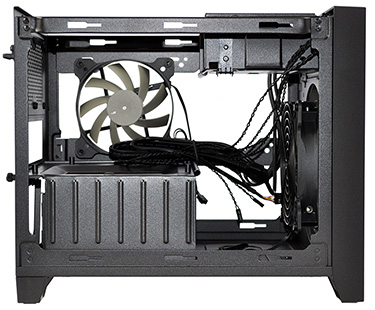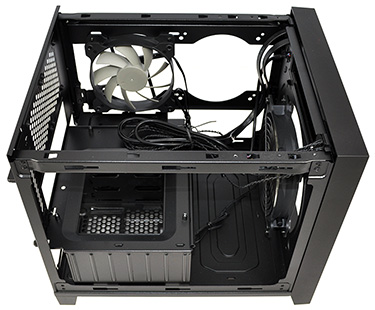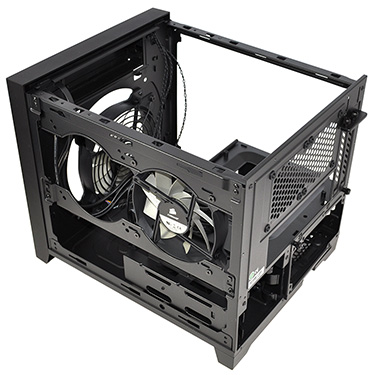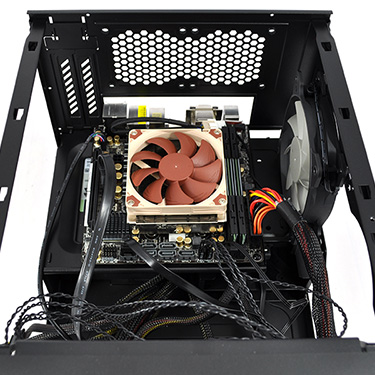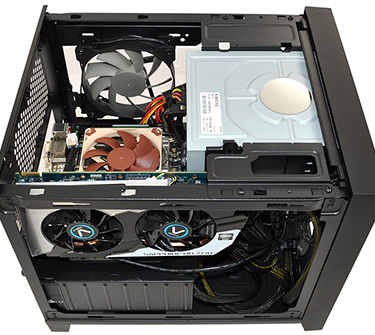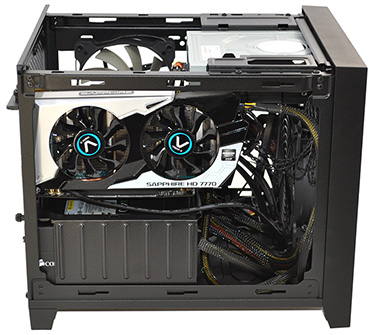Building into the 250D
With the top and side panels removed, users can undo four screws and slide out the optical drive bay - it's a chunky piece of metal and we'd highly recommend carrying out the initial build with the unit removed. With everything opened up, the 250D feels surprisingly roomy. For a Mini ITX enclosure, space never seems to be an issue, even when building with multiple full-size components.
In terms of layout, Corsair has the power-supply bay mounted at the bottom rear, and the bay itself acts as a tray for your Mini ITX motherboard. There's plenty of space in front of the PSU bay for excess cables, and there's no shortage of cable tie-down points, either.
Serving both air- and liquid-cooling users, the chassis ships with a total of five fan mounts. These include a 120/140/200mm mounting point up front, two 120mm mounts to the side and dual 80mm mounts at the back. By default, a 140mm AF140L front intake is pre-installed along with a 120mm AF120L fan on the side.
The default cooling configuration should serve most users well - there are plenty of mesh openings to aid airflow - but we suspect you'll be buying the 250D with liquid-cooling in mind. Take out the standard 120mm side exhaust and you'll easily be able to slot in a 240mm radiator - it's essentially a perfect match for Corsair's own H100i. Bear in mind you'll be able to attach two fans to the radiator, but not four in a push/pull configuration, at least not without heavy modifications.
Corsair chassis have historically been easy to work with and the 250D is no exception. Installing the PSU entails removing a rear bracket that's held in place with two thumbscrews, sliding in any ATX supply and then screwing it into place. The fit is secure and there's a pull-out dust filter underneath.
Similarly, the storage bays are located to the left of the PSU bay and are covered by a rear grill. Undoing a further four thumb screws (get used to those, the 250D has plenty of them) provides access to the four trays - two 3.5in and two 2.5in - and each one is tool-free. The plastic trays don't feel particularly robust but they serve their purpose. It's worth noting, also, that the 3.5in bays do offer 2.5in mounting holes, so if your pockets are deep, you could equip the 250D with four SSDs.
Our Mini ITX test platform isn't quite so lavish and consists of an ASRock FM2A85X-ITX motherboard, an AMD A10-6700 APU, 16GB of Adata XPG DDR3 memory, a low-profile Noctua NH-L9a cooler, a Sapphire HD 7770 Vapor-X graphics card and a Corsair CX430 power supply.
The aforementioned components have been a tight squeeze in other SFF chassis, but with the Obsidian Series 250D they fit in with room to spare. Sapphire's HD 7770 causes no problem, and there's evidently ample space for a dual-slot card measuring up to 290mm in length. What's handy is that Corsair has also left a cutout in the optical-bay mount, allowing for easier access to graphics cards with upward-facing power connectors.
The 250D's objective is to facilitate high-end Mini ITX builds and we can see no obvious shortcomings in this regard. This may be Corsair's smallest chassis to date, yet it's still geared for full-performance components.
We're expecting to see consumers and system integrators outfit the 250D with an overclocked Intel Haswell CPU, a meaty discrete graphics card and liquid cooling, and we don't envisage heat being too big a problem. The chassis had absolutely no trouble in cooling our AMD APU and Radeon HD 7770 with just the pre-installed fans - GPU temperature didn't exceed 65ºC when gaming at 1080p - but there is an acoustic trade-off to be aware of.
With so many mesh openings, the 250D does little to quell system noise and even with our modest test components, we found the PC too vocal for our liking. The open airflow design is ideal for cooling, but as a consequence dust and noise can be a problem: we like to think of Mini ITX PCs as desktop systems that can live unobtrusively alongside a monitor, yet without carefully-selected components or third-party soundproofing, silencing the baby Obsidian is going to be a challenge.






